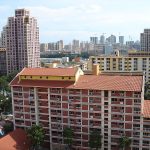As we enter the month of April, it is income tax season, the rush to file for taxes is steadily building up. For those of you who haven’t submitted your tax declarations, now is a good time to take 45 minutes of your time to submit your taxes. While Singapore already has one of the lowest income tax in the world, getting any additional saving is still welcome. Thus, we decided to create this ultimate income tax guide that will help you ace your income tax game legally. (P.S. We are not asking you to evade taxes.)
Although Singapore has a low personal income tax rate, home loan interest cost or commercial property loan interest cost are not tax deductible.

Step 1: Determine Your Taxable Income
Table of Contents
Let’s start with the most basic step of calculating how much is your income for the year of assessment.
For most small and medium enterprises (SMEs) or large corporations, it is likely that your income is already in the database of IRAS. Your employer would most likely have registered for e-filing to declare your income (basic plus bonus) to IRAS. But for basic understanding of income tax and the benefit of those whose company still hasn’t e-filed to declare their employees’ income, we will explain how to determine your taxable income tax.
The following types of income are all considered as taxable income according to the latest information on the IRAS website. By taking the sum of all taxable income, you will be able to determine your taxable income.
| Employee salary | Employee bonus | Commission | Allowances | Salary-in-lieu of notice or termination of contract | Rental income |
| Freelance work | Annuity | Trust income | Part-time work | Gains from exercise of stock options | Employee share ownership |
Step 2: Understanding Singapore’s Tax Bracket Structure
Chargeable Income vs Taxable Income
To understand Singapore’s tax bracket structure, we first need to understand the concept of chargeable income. Chargeable income is often being confused with taxable income by Singaporeans, but they are not the same.
Chargeable income = Taxable income – personal tax reliefs.
We will elaborate further on this once you have understood Singapore’s tax bracket structure.
Singapore Income Tax Bracket Structure
Singapore’s tax system is built on a progressive tax scheme. This means that the more you earn, the higher amount of taxes you will have to pay. Thus, there is an income tax bracket structure that will determine how much taxes you will need to pay depending on your chargeable income.
| iCompareLoan’s Interpretation | Chargeable Income | Income Tax Rate (%) | Gross Income Tax Payable ($) |
| Your Chargeable Income Is Between $0 – $30,000 | First $20,000 | 0 | 0 |
| Next $10,000 | 2 | 200 | |
| Your Chargeable Income Is Between $30,000 – $40,000 | First $30,000 | – | 200 |
| Next $10,000 | 3.5 | 350 | |
| Your Chargeable Income Is Between $40,000 – $80,000 | First $40,000 | – | 550 |
| Next $40,000 | 7 | 2,800 | |
| Your Chargeable Income Is Between $80,000 – $120,000 | First $80,000 | – | 3,350 |
| Next $40,000 | 11.5 | 4,600 | |
| Your Chargeable Income Is Between $120,000 – $160,000 | First $120,000 | – | 7,950 |
| Next $40,000 | 15 | 6,000 | |
| Your Chargeable Income Is Between $160,000 – $200,000 | First $160,000 | – | 13,950 |
| Next $40,000 | 18 | 7,200 | |
| Your Chargeable Income Is Between $200,000 – $240,000 | First $200,000 | – | 21,150 |
| Next $40,000 | 19 | 7,600 | |
| Your Chargeable Income Is Between $240,000 – $280,000 | First $240,000 | – | 28,750 |
| Next $40,000 | 19.5 | 7,800 | |
| Your Chargeable Income Is Between $280,000 – $320,000 | First $280,000 | – | 36,550 |
| Next $40,000 | 20 | 8,000 | |
| Your Chargeable Income Is More Than $320,000 | First $320,000 | – | 44,550 |
| In excess of $320,000 | 22 |
This table might be confusing, especially if it is the first time you have seen it. To make it easier for understanding, we have added an easier interpretation of the tax bracket.
Step 3: Tax Reliefs To Reduce Your Chargeable Income
Now that you have a better understanding of the tax bracket structure, we can go into the main discussion on reducing your chargeable income to move you down the income bracket.
Tip 1: Approved Donations Can Be Deducted From Taxable Income
One thing to note is that, approved donations to an approved Institution of a Public Character (IPC) or the Singapore Government for causes that benefit the local community are deductible donations. It can be in cash, artefacts, artworks. Donations usually have multiplied effect on tax deduction. For example, if you donated $10,000 to an approved institution, you will be able to reduce your taxable income by 2.5 times of your donated amount, i.e. $25,000.
Taxable Income = Total Taxable Income – Deductible Donation
For example, if you earned $100,000 in 2017 and donated $10,000, your taxable income will be $75,000 ($100,000 – (2.5 x $10,000)). Donation can be useful in helping you deduct your taxable income, which in turn reduces your chargeable income.
Tip 2: Personal Tax Reliefs
There are various different personal tax reliefs that can be claimed to help you lower your income tax bracket.
NSMan Relief
Be it whether you have fulfilled your NSMan obligations for the year, you will be able to claim for NSMan relief. NSMan relief is automatically registered with IRAS. Thus, you do not need to manually enter it into your income tax declaration.
If you have been recalled in the past year (i.e. 2017), you will be able to reduce your chargeable income by $3,000. If not, you will still be able to reduce it by $1,500. If you are a key appointment holder (e.g. OC, CSM, S1, S2, etc), you will be able to claim $3,500 and $5,000 NSMan tax relief for non-recall and recall respectively. Your parents and wife are also entitled to NSMan relief from your NSMan activities. Each of them are entitled to $750 in tax relief, regardless of whether you were recalled or not.
Parent Relief
If you are taking care of your parents, parent-in-laws, grandparents or grandparent-in-laws, then this is the relief you need to take note of. There are few criteria that need to be met. The dependant(s) needs to be above 55 years old and do not have an annual income excluding $4,000 in the year of assessment (i.e. 2017). For each dependant that stays with you, you can claim $9,000 parent relief. If they do not stay with you, you can claim $5,500 in parent relief from each dependant.
However, if you have a few siblings, you need to take note that the parent relief can only be claimed by one person. This means that you and your siblings cannot both claim parent relief for your father.
Foreign Domestic Worker Levy Relief
This is probably the only time you will appreciate the foreign domestic worker levy that you have shelled out for your maid. According to IRAS, you have the right to claim twice the total foreign domestic worker levy paid in the previous year. However, you can only claim for one foreign domestic worker regardless of how many foreign domestic worker you hire.
Step 4: Tips To Reduce Your Chargeable Income
What if you are still slightly short of some tax relief to help you lower your tax bracket? What else can you do?
Tip 1: Voluntary CPF Top Up
Instead of paying more taxes, why not save that money in your CPF by making a voluntary top up of your CPF? You can also choose to top up your spouse, or your parents’ CPF Special Account. For every dollar that you decide to top up, you will get a dollar-for-dollar tax relief from your chargeable income. The maximum amount you can top up in every year is $7,000 on your personal CPF and a further $7,000 to your spouse or parents’ CPF.
Tip 2: Top Up Your Supplementary Retirement Scheme
Another way you can reduce your chargeable income is by making voluntary contribution to your supplementary retirement scheme (SRS). Similar to the voluntary CPF top up, each dollar contributed to SRS is eligible for a dollar-for-dollar tax relief from your chargeable income. The cap for annual SRS contribution is set at $15,300.
Step 5: Pay Your Income Tax Like An Honest Taxpayer
The final and most important step is to pay your income tax like an honest taxpayer. Apart from the legitimate reliefs that we have shared, do not attempt illegal ways to bypass your income tax. It is not worth getting into trouble with the tax authorities and losing your peace of mind.
For those people who are in business, they will find that if they declare too low an income, this will have serious implications on their Home Loan as well as Commercial Property Loan borrowing capacity (under investment holding structure), worse still many may not be able to refinance their properties cheaply. Remember, there is no escape from the tax man. Death and taxes are the only certainty in life.
If you have an existing housing loan, it is important to check how much income is needed to support a property purchase or simply to refinance over your home to a cheaper home loan package. Remember, although MAS allows Owner-occupier units to refinance without passing Total debt Servicing Ratio (TDSR), Singapore banks are setting stricter criteria, and hence may not want to take over your loan. Then you are stuck paying a higher interest cost while saving some income tax.






